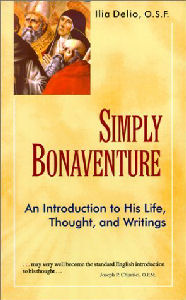
|
Posted July 21, 2005
Book: Simply Bonaventure Author: Ilia Delio, O.S.F. New City Press, Hyde Park, NY, pp.208 An Excerpt from the Introduction:
Although it is somewhat presumptuous to call this book Simply Bonaventure in light of the complexity of Bonaventure’s thought, I believe the essence of his thought is contained in a simple formula that Bonaventure himself professed: “This is our entire metaphysics: emanation, exemplarity, and consummation, that is, to be illumined by rays of spiritual light and to return to the Most High.” Translating this into more contemporary terms Bonaventure was ultimately concerned with three questions: 1. Where have we come from? 2. What are we doing here? 3. Where are we going? Rather than approaching these as open-ended questions, however, Bonaventure began with the conviction of faith in God who has revealed himself to us in Jesus Christ. “Unless we are able to view things in terms of how they originate, how they are to reduced to their end, and how God shines forth in them, we will not be able to understand.” Always searching for the ultimate ground of truth, he came to perceive the fullness of truth in Jesus Christ. Thus, he indicated, if we want to know the ground of our being, the purpose of our existence, and the goal to which we are directed, we must come to know Christ who is the center of our lives and our universe. An Excerpt from the Book: Once upon a time, the story goes, Abba Lot went to see Abba Joseph. He said, “Abba, as much as I am able, I practice a small rule, all the little fasts, some prayer and meditation, and remain quiet. What else should I do?” To which the old monastic stood up and stretched his hands toward heaven, and his fingers became like ten torches of flame. And he said, “Why not be completely turned into fire?” This is a powerful story about human desire. How many of us wake up in the morning with the desire to be turned into fire? How many of us are so consumed by the fire of God’s love that we are willing to suffer so as to be purified in love? Bonaventure frequently used the image of fire to describe the type of love the Christian must have if s/h truly desires God. “Listen Mother,” he write to a Poor Clare nun, “your heart is the altar of God. It is here that the fire of intense love must burn always.” Burning love is the love that enflames from within, “in one’s very marrow,” as Bonaventure writes; it is the fire of the Holy Spirit. Such love cannot be hidden or anonymous for by nature it radiates on the face of the believer. Table of Contents: Bonaventure’s Life From Paris to Assisi Bonaventure’s Thought Trinity Creation Humanity Incarnation Journey to God Imitation of Christ Contemplation Peace Reducio Excerpts of Bonaventure’s Writings A note on the writings Whether the human person is truly an image of God Primacy and Trinity A letter to the abbess and sisters of Saint Clare in Assisi From the prologue to the Tree of Life On the Third Commandment of the Decalogue: Collation IV First collation on the Six Days of Creation |
|
